BESTIARY
INTRODUCTIONIf there's any lasting legacy of the royal line of Hypocrates, it's genocide. This was accomplished through two primary means; the brutality of Neovictorian Change Cage society and the genetically-engineered man-eating prehistoric beasts. This section looks at some of the weird and wonderful uber=besats that were introduced into the wild by Victor II. A few more mundane animals are also described (such as the beasts of burden in use by the Neobedouins). The list is by no means exhaustive. Most of the creatures that existed before the screwing up of the timeline can still be found in the wilderness - although some of them were brought to extinction through loss of habitat, over-hunting before the Great Apocalypse and the re-introduction of the new predators.
PEOPLE ON THE MENUWhen Victor II oversaw the bio-engineering program that led to the creation of the uber-beasts, he had very specific ideas about what hte reintroduction of mega-fauna would mean for humanity. He demanded that a taste for human flesh should be hard-wired into the predators. The consequence is that the carnivorous beasts scent humans as prey, and especially tasty prey at that. Thsi does not cause them to lose all sense of self-preservation, but does mean that they are liable to stalk potential human targets for longer, and that if they find vulnerable, solitary or undefended people, they are more likely to go into a killing frenzy.
The "Great Rectification" was achieved using technology that has since been outlawed. Yet Victor III still has access to the secrets and to a few remote research stations, inhabited by those with the skills to create still more species. Whether they will or not, and what horrors they might unleash, remains to be seen.
The scientists made the Uber-Beasts especially robust. The statistics given are generally those for average examples of a species. There are bigger and smaller versions of many of the beasts to be encountered, different subspecies which may be lower down the food chain, and younger creatures who are not yet grown.
 ALLIGATOR
ALLIGATORType: Predator
Habitat: Wetlands
Alligators had been virtually wiped out, victims of a loss of habitat as humans drained the wetlands. Since the "Great Rectification", they have flourished once more. with large bodies, thick clawed limbs, powerful tails and rows of vicious teeth, although they are not especially bred uber-beasts, they can still be extremely dangerous. They can grow up to 15 feet, move extremely fast while in the water and, although seeming slow-moving out of it, they can nevertheless run for short distances very quickly (for a maximum of three turns, after which they give up).
They can be found throughout most of the south (although not the extreme southwest). Alligators are quite happy to see humans as potential prey; the wariness they once had, pre-Apocalypse, has deminished, now that humans are rarer and no longer pose such a threat. Even if not particularly hungry, they will attack anyone going near their eggs or young. Aside from the giant alligators, their bite is the most powerful there is. Even surviving that, the chances are that infection will set in, merely replacing a swift death with a long and agonizing one. If their bite doens't get you, then their tails might - one bone-crunching swish is enough to take someone down. There are also crocodiles to be found near the Change Cage city of Everglade. Crocodiles rarely attack humans, but they will.
 AMERICAN CHEETAH
AMERICAN CHEETAHType: Predator
Habitat: Prairies and Plains
The American Cheetah is a fast and deadly animal. They can grow up to at least 6 feet in length, and weigh up to 150 lbs. They have long legs, a slender body and short snouts. An American Cheetah can race along at 60 miles an hour and its tough, retractile claws are designed so that they can grip onto their prey, even at such high speeds. This means that if a victim were to survive the shock of impact, escape once in the creature's clutches is nigh on impossible.
Their incredible turn of speed means they are able to catch the most swift-footed plains grazers. So, if you see one coming, running won't help you. Bred with a taste for human flesh, people caught in the open have no chance unless they are extremely well-armed or have the phenomenal reflexes of a beast dancer. Even then, most wise money would go on the Cheetah.
 AMERICAN LION
AMERICAN LIONType: Predator
Habitat: All
Standing over 4 feet tall at the shoulder, 12 feet long and weighing up to 700 lbs, the American Lion is a heavy muscular beast, able to catch and kill large prey and bully other predators off their kills. Their terrifying jaws are filled with razor sharp teeth, and they have powerful retractable claws with which to grip their prey. Aside from a small area along the east coast, they are a hazard right across the continent. Where it is colder, they might use a cave as a shelter. In warmer climes, such as forests, they make a den on the floor. Wherever they are found, they are bred to love a diet of human beings, and they present a terrible danger to the Free People.
Able to bring down mammoths, the American Lion is at the top of the food chain, a beast not to be taken lightly.
 BISON
BISONType: Food
Habitat: Forests and Plains
Bison have long brown shaggy winter coats, to protect them in the winter months, light tan ones in the summer. Bulls can grow up to 7 feet tall at the shoulder, 12 feet long and are long-horned and heavy beasts. They are hunted by the Neobedouins, who eat them, or sell the meat to the Neovictorians who can't get enough of them, and are willing to pay very high prices for the best cuts. The Neobedouin also highly prize their hides, which they decorate and either wear or use in the construction of their yurts and caravans. bison spend most of their day avoiding predators, grazing and wallowing in the mud.
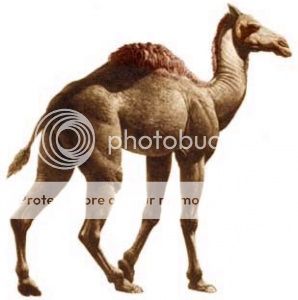 CAMELOPS
CAMELOPSType: Food and Beast of Burden
Habitat: All except Arctic and Tundra
Camelops are similar to camels, but over 7 feet tall at the shoulder. They are used by the Neobedouin as mounts. A well trained camelops is considered better than a horse by many of the Neobedouin. They can eat the most scraggy greenery, and require little water considering the distances they can travel. Some of them are used to pull small caravans, although they are notoriously slow and grumpy if put to this work. Many of the desert tribes herd camelops to be bartered or sold for meat, or to those other tribes who might want to use them as mounts or to pull their homes. If they are on the menu, then their hides won't be wasted, but fashioned into blankets and clothing.
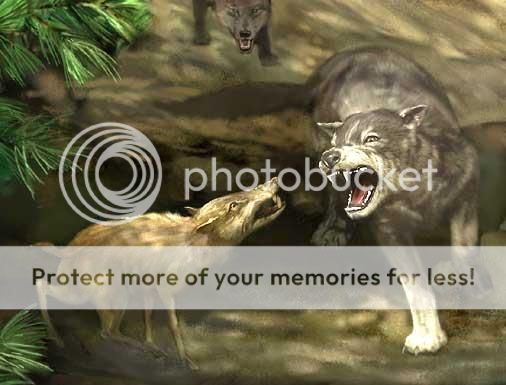 DIRE WOLF
DIRE WOLFType: Predator
Habitat: Any
Dire wolves are similar to other wolves, but much larger (they grow up to 5 feet long and weigh up to 240 lbs), with broader jaws, longer teeth and sturdier legs. They hunt as a pack and can smell humans from miles away. Once they have a scent they can follow their targets over great distances with ease.
When they are not chomping humans, dire wolves mainly live off bison and horses. They harry at the beasts, tearing chunks of of them until eventually they fall and are overwhelmed by the pack.
There have been rumors that it's possible to actually tame a Dire Wolf as a pet, but as of this writing those rumors are unsubstantiated.
 DOG
DOGType: Pet/Working/Food
Habitat: Any
Dogs once came in many shapes and sizes but since the Great Apocalypse, the larger, stronger breeds became dominant. Neobedouin keep dogs, mainly using them to help with the herding, and sometimes as pets.
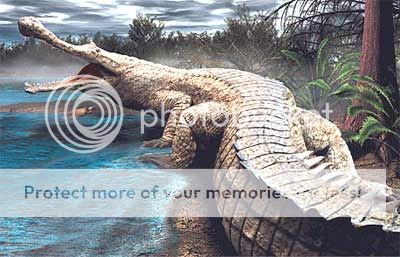 GIANT ALLIGATOR
GIANT ALLIGATORType: Predator
Habitat: Wetlands
The giant alligators look much like, and live in the same areas as, ordinary gators. But they grow much bigger - they grow to over 40 feet long and weigh up to 15 tons. They have large teeth, particularly useful for crushing. Their bite is twice as hard as that of their smaller relatives - when they bite something they usually just tear straight through it. When they hunt through murky waters, all that can be seen of them is their nostrils, the rest of their immense bulk hidden below the water line.
Their favorite method of hunting is ambush. As prey moves toward the river bank to drink, they lunge out and bite. Due ot the changes made in their genetic coding, they are especially fond of eating people and know where to gather to catch those Neovictorians expelled from Everglade. Skyfolk maintain that they have flown over even bigger specimens - the size of whales.
 GIANT CONDOR
GIANT CONDORType: Predator
Habitat: Warm and Mountainous
Vulture-like, giant condors have huge bills and can weigh as much as 150 lbs. Unlike vultures, they do not live by scavenging alone; they can sweep down and catch prey in flight. With a wingspan of up to 25 feet, they are a terrible sight as groups of them gather around, in the air above a Neobedouin caravan, before plunging down to strike. Giant condors try to avoid being grounded, as away from the mountains they struggle to get the momentum needed for flight.
Giant condors range over most of western and southwestern North America, but are sometimes found further afield. As well as attack the Neobedouin, they have been known to flock around the Change Cage cities, causing those on the sidewalks to run for cover. When hunting humans, who they find delicious, they tend to try to pick off infants rather than adults. They sometimes attack airship crews as well - many a midshipman or cabin boy has been snatched from the rigging by a hungry giant condor.
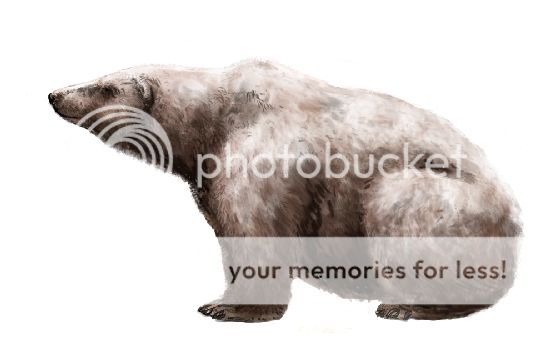 GIANT POLAR BEAR
GIANT POLAR BEARType: Predator
Habitat: Arctic
Giant polar bears weigh over a ton, and are twice the size of a human when stood up on their hind legs. They can take out large prey fairly easily. They do this by using their massive forelimbs to grab and wrestle their target. They generally eat large walruses, but are quite happy to vary their diet if humans are available. the ones near Old Borealis especially enjoy a treat when some poor soul is banished from the walls.
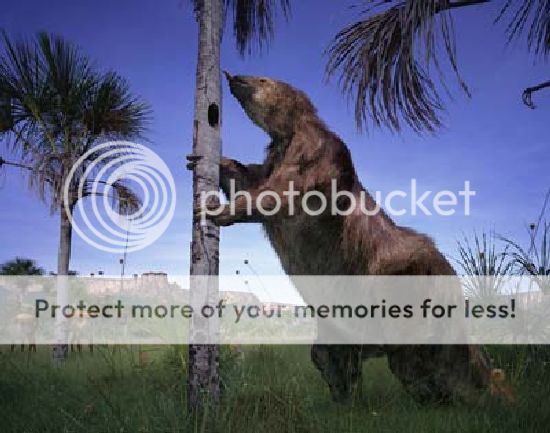 GIANT SLOTH
GIANT SLOTHType: Best Avoided
Habitat: Forest
Although mostly harmless unless disturbed, their immense size means that giant ground sloths are best avoided. Weighing as much as a bull elephant, and 20 feet tall when stood up on their hind legs (twice the height of an elephant), the sheer size of the giant sloth is enough to deter most predators. If that isn't enough, they have long, razor sharp claws shaped like sickles. When moving on all fours, these claws cause the giant sloth to shuffle in a most peculiar fashion.
 HORSE
HORSEType: Beast of Burden/Food
Habitat: Plains
A horse is a horse. Of course.
Used as mounts, pack-horses and to pull small caravans. Also used as food by a variety of predators.
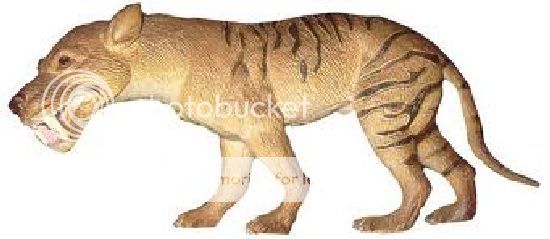 HYAENADON
HYAENADONType: Predator
Habitat: Any
Hyaenodons have long, narrow snouts, long bodies and long tails. The largest are huge - standing over four feet tall at teh shoulder and 10 feet long. They are extremely fast, can turn on a dime and when they have killed their prey, their bone-grinding teeth are so tough that they can eat every part of their victim. Hyaenodons hunt mainly at night, gathered in packs so that they might hunt larger b easts, although they will often pick off the youngest, weakest or lone animals to conserve their energy.
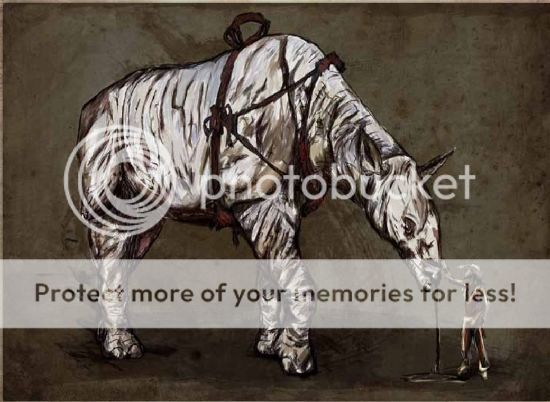 INDRIKKUS
INDRIKKUSType: Beast of Burden
Habitat: Forest
Indrikki are truly massive animals. 18 feet tall at the shoulder, 30 feet long, and able to stretch their necks up to heights of over 25 feet to feed, these 20 ton animals are so big that even the most vicious predators will only attack an infant Indrukkus. Their upper teeth are tusk-like, and they have a supple, mobile upper lip, which they use to strip trees of their greenery. They ahve long necks and thick bodoes and legs. Their hide is very tough, providing them with another defense.
They resemble an over-sized and bulky cart horse, and this is the role they often fulfill for the Neobedouin. Desptie being slow and needing to browse, the Indrikki are capable of pulling the larger caravans and can even be harnessed to pull the smaller steam trucks if they get into trouble, have engine failure, get stuck, etc. They have an extremely docile nature and will happily carry a howdah on their wide backs, giving their rider a good view of the surrounding area. Their tempers wear thin, however, if their young are threatened or they are gathered together in a herd and startled by fire or predators - in which case get out of the way, as "you only get stepped on by an Indrikkus once!".
 MAMMOTH
MAMMOTHType: Beast of Burden/Food
Habitat: Arctic, Forests, Hills and Plains
Mammoths graze throughout much of North America. The grazers on the central plains are more than twice the height of a person at the shoulder, and weigh 10 tons or more. Their tusks can grow up to 14 feet long. The northern species have a covering of long, woolly hair, to protect them from the cold. They are much sought after by Neobedouin who domesticate them to ride or pull their wagons (or both at once) or slaughter and sell as meat to the Neovictorians.
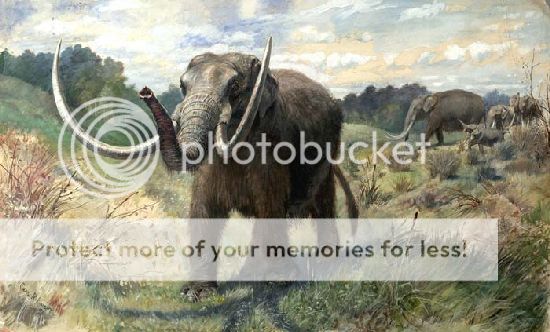 MASTODON
MASTODONType: Beast of Burden/Food
Habitat: Forests, Hills and Plains
Generally a little smaller than mammoths (about 8 feet tall at the shoulder and weighing about 5 tons) and more suited to foraging than grazing, tucking in to fallen leaves and pine needles. Mastodons are fairly similar in temperament to their larger cousins and are used by the Neobedouin for similar purposes.
 RACID
RACIDType: Predator
Habitat: All
Racids, commonly called "terror birds" are giant flightless birds that can be found just about anywhere. Although generally content to scavenge or hunt for small prey, the larger specimens truly are terror birds, growing over 12 feet tall and with a viciously sharp, eagle-like beak. Although they look somewhat ungainly, they can run at 30 miles an hour. Racids are incredibly ill-tempered and have a proclivity for human flesh.
 SABRE-TOOTHED CAT
SABRE-TOOTHED CATType: Predator
Habitat: All
Standing over 4 feet tall at the shoulder, with foot-long canines and massive forequarters, the sabre-toothed cat is a fearsome sight. Heavy for a big cat, the sabre-tooth can bring down large prey, including young mastodons and mammoths. An unarmed human is not much of a challenge and a welcome treat. Although their grip and bite can be fatal in itself, often they deliver a massive ripping wound with their enlarged canines and allow their prey to slowly die from blood loss.
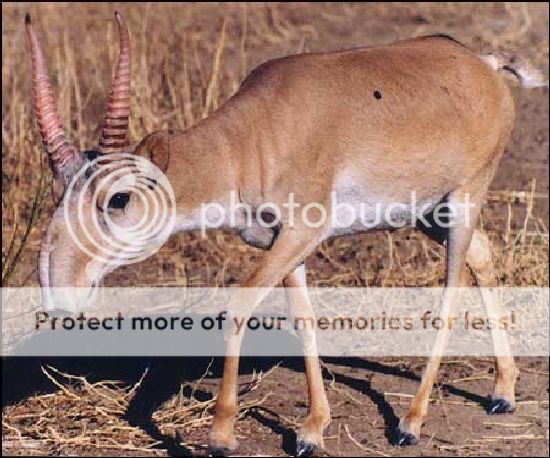 SAIGA ANTELOPE
SAIGA ANTELOPEType: Food
Habitat: Plains
Large herds of saiga antelopes roam the plains, preferring these open spaces, where they can see predators coming from a long way off. They are about the size of a large dog and have cream colored fur which keeps them warm in colder climes. They are a major food source for many predators. They have excellent eyesight and are nimble, so usually larger predators content themselves with picking off the weaker and older antelopes, while the rest of the herd makes its escape. They can survive off scrubby plants, which other animals find unpalatable or poisonous and so roam into semi-desert areas. They can also swim, and herds travel great distances to find food.
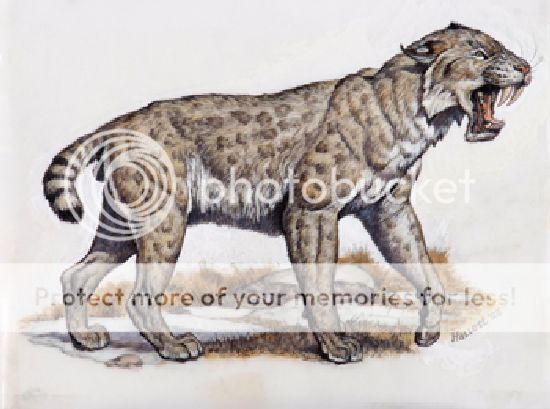 SCIMITAR CAT
SCIMITAR CATType: Predator
Habitat: Desert and Plains
The scimitar cat is a fast, extremely agile predator the size of a lion, but more slender in the body. Hiding up a tree own't help you avoid a scimitar cat, they are excellent climbers. Their jaws are so strong and their bite so vicious that they can bring down bison and even young mammoths. They hunt and scavenge in packs - their bodies are shaped somehwat like a hyena's, with long front limbs and squat, powerful hindquarters. This allows them to make sudden, long murderous leaps - their fast speeds meaning they are equally adept at running down or ambushing prey.
 SHORT-FACED BEAR
SHORT-FACED BEARType: Predator
Habitat: Forests and Plains
On all fours, a short-faced bear is as tall as a man; stood up they are over 12 feet tall. The short-faced bear uses its bulk when attacking (they weigh just under a ton), but their long powerful legs allow them to run up to 40 miles an hour, an incredible pace for such a large animal, enough to allow them to surprise even horses and saiga antelope. Bio-engineered to attack humans, the short-faced bear is a formidable foe.
 SHRUB OX
SHRUB OXType: Food
Habitat: Forests and Hills
Massively built and standing at a height somehwere between a bison and a muskox, these gentle browsers live off a diet of shrubs and leaves. They are a popular illegal foodstuff amongst the Neovictorian upper class, and therefore a prized catch for a Neobedouin.
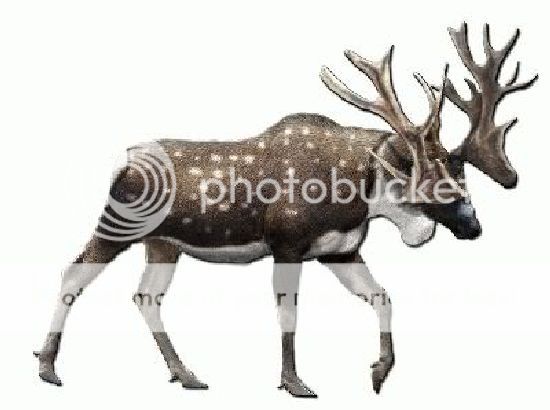 STAG-MOOSE
STAG-MOOSEType: Food
Habitat: Forests
The stag-moose looks exactly as it sounds, like a cross between an elk and a moose although larger. Their intricate antlers are sought after by the Neobedouin, who like to carve and decorate the material (shamans sometimes wear them when conducting special rituals), and stag-moose meat fetches a good price from the Skyfolk and Neovictorians.
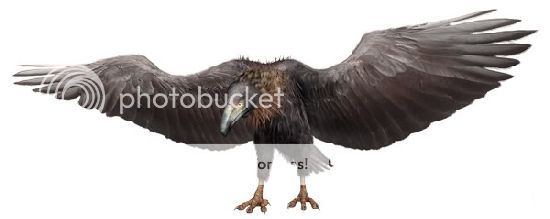 TERATORN
TERATORNType: Predator
Habitat: All
Teratorns are similar to their larger cousins, the giant condors and equally as vicious. Their smaller wingspans (about 12 feet) and lighter bodies mean that they will only attempt to attack larger prey if they are flocked together, and are more able to land and scavenge like the vultures they resemble. (as unlike the giant condor, they don't struggle as much to get back up in the air). Nevertheless, their gripping claws and ability to swoop down and scoop up smaller prey means, if spotted, Neobedouin parents make sure their babes are close when teratorns are in the skiws above them.
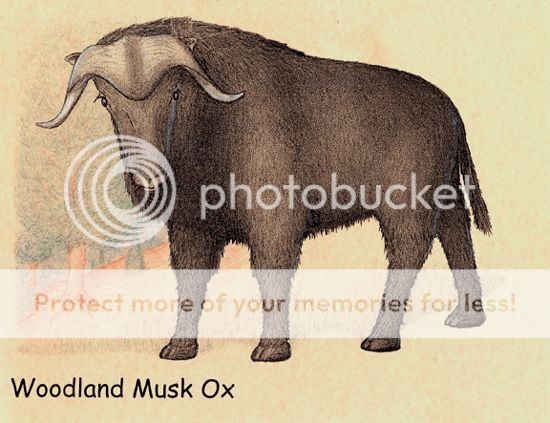 WOODLAND MUSKOX
WOODLAND MUSKOXType: Food
Habitat: All (except Desert)
Smaller than the shrub ox (the larger males standing 5 feet high at the shoulder) with long, dense, shaggy hair, the muskox is particularly fond of grazing on the plains or foraging in wooded areas. Muskox have large, curving horns. The woodland muskox is another animal that the Neobedouin hunt for food and skins, and that the Skyfolk and upper class Neovictorians enjoy eating.
